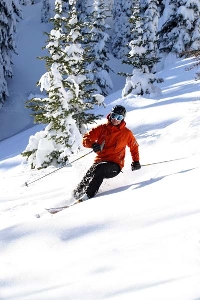
Sensible clothing for skiing
While you might expect common sense to prevail when figuring out what to wear skiing, you would be surprised how many people leave that behind as they head for the slopes. It goes without even saying that you want to choose clothes that will keep you warm and dry. This is especially important if you are a beginner, as you can expect to fall a few times. It is more than likely that you already own most of the things you will need and can probably borrow others from friends. Still you might have to by some protective gear like goggles and helmets.
You must protect your body and the sum of all its parts while out there skiing up (and hopefully, never through) a storm. Here are some ideas to help you along your icy way as you decide what to wear skiing.
Some advice about what to wear skiing
~
1- Helmet/headwear
Remember what your mother always told you about the amount of heat that escapes through your head? Well, she was right, and helmets or knit hats are the best way to keep your head warm when out on those slopes. If you don?t want to believe that, then I have just two words for you: Natasha Richardson. Remember her? If you choose to wear a helmet, you should select one that breathes appropriately for you as well as one that fits with your favorite goggles.
2- Avoid cotton clothing
Although cotton has been a ubiquitous blessing for man and womankind, avoid wearing jeans, sweatshirts and sweatpants next to your skin when out there skiing. This is because cotton absorbs sweat and makes you feel chilled. The same is true with your choice of socks; wool or acrylic fare much better than cotton athletic varieties out there on those cold trails. Wear only one pair as ski and snowboard boots are designed specifically for warmth. Thick socks or multiple layers of socks are certain to give you blisters.
3- Layer up
What to wear skiing in some ways follows the same guidelines as general winter attire. The 3-layer tactic offers the flexibility of adding or removing layers, depending on the weather conditions and your particular activity level. The three layers include: a wicking layer, which is next to your skin and is usually long underwear, an insulating middle layer for sweaters and sweatshirts and the protection layer which serves as the exterior guard against the elements of winter.
When buying supplies for what to wear skiing, look for synthetic thermal underwear (usually polyester), which has a ?wicking power.? While this sounds somewhat mysterious, all it means is that the fiber will ?wick? (or move) moisture away from your skin and it will evaporate after it passes through the fabric, keeping you warm and dry and comfortable. Silk also has wicking ability.
The insulating middle layer keeps heat in and cold out by trapping air between the filters. Polypropylene and fleece as well as wool and silk are particularly powerful as insulators. Winter shells and pants are perfect for the exterior layer as they are made waterproof and breathable by using tightly woven fabrics and a coating or laminate that repels water from snow and blocks the wind while also letting perspiration evaporate.
4- Eyewear
Choose sunglasses or goggles that offer 100-percent eye protection against UV rays and are large enough to shield your eyes from wind, blowing snow and wind chill. Goggles are better in the snow.
Be a boy scout even if you are a girl and prepare yourself well for your next ski trip. This way, it is unlikely that you will make a mistake when deciding what to wear skiing.
Remember that common sense must prevail out there on that ski trail or in some instances?you might not.
